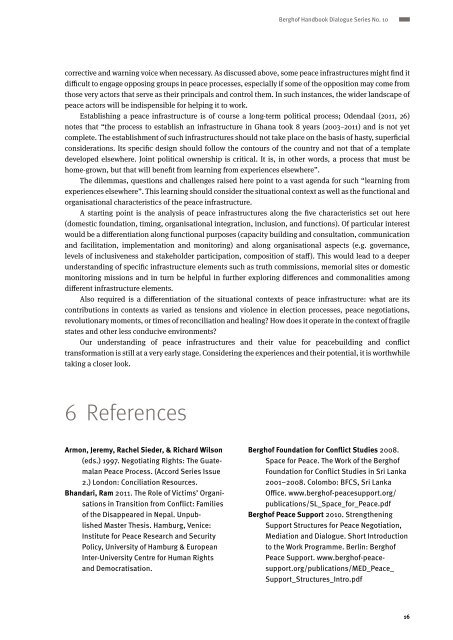Giving Peace an Address? - Berghof Handbook for Conflict ...
Giving Peace an Address? - Berghof Handbook for Conflict ...
Giving Peace an Address? - Berghof Handbook for Conflict ...
You also want an ePaper? Increase the reach of your titles
YUMPU automatically turns print PDFs into web optimized ePapers that Google loves.
<strong>Berghof</strong> H<strong>an</strong>dbook Dialogue Series No. 10<br />
corrective <strong>an</strong>d warning voice when necessary. As discussed above, some peace infrastructures might find it<br />
difficult to engage opposing groups in peace processes, especially if some of the opposition may come from<br />
those very actors that serve as their principals <strong>an</strong>d control them. In such inst<strong>an</strong>ces, the wider l<strong>an</strong>dscape of<br />
peace actors will be indispensible <strong>for</strong> helping it to work.<br />
Establishing a peace infrastructure is of course a long-term political process; Odendaal (2011, 26)<br />
notes that “the process to establish <strong>an</strong> infrastructure in Gh<strong>an</strong>a took 8 years (2003–2011) <strong>an</strong>d is not yet<br />
complete. The establishment of such infrastructures should not take place on the basis of hasty, superficial<br />
considerations. Its specific design should follow the contours of the country <strong>an</strong>d not that of a template<br />
developed elsewhere. Joint political ownership is critical. It is, in other words, a process that must be<br />
home-grown, but that will benefit from learning from experiences elsewhere”.<br />
The dilemmas, questions <strong>an</strong>d challenges raised here point to a vast agenda <strong>for</strong> such “learning from<br />
experiences elsewhere”. This learning should consider the situational context as well as the functional <strong>an</strong>d<br />
org<strong>an</strong>isational characteristics of the peace infrastructure.<br />
A starting point is the <strong>an</strong>alysis of peace infrastructures along the five characteristics set out here<br />
(domestic foundation, timing, org<strong>an</strong>isational integration, inclusion, <strong>an</strong>d functions). Of particular interest<br />
would be a differentiation along functional purposes (capacity building <strong>an</strong>d consultation, communication<br />
<strong>an</strong>d facilitation, implementation <strong>an</strong>d monitoring) <strong>an</strong>d along org<strong>an</strong>isational aspects (e.g. govern<strong>an</strong>ce,<br />
levels of inclusiveness <strong>an</strong>d stakeholder participation, composition of staff). This would lead to a deeper<br />
underst<strong>an</strong>ding of specific infrastructure elements such as truth commissions, memorial sites or domestic<br />
monitoring missions <strong>an</strong>d in turn be helpful in further exploring differences <strong>an</strong>d commonalities among<br />
different infrastructure elements.<br />
Also required is a differentiation of the situational contexts of peace infrastructure: what are its<br />
contributions in contexts as varied as tensions <strong>an</strong>d violence in election processes, peace negotiations,<br />
revolutionary moments, or times of reconciliation <strong>an</strong>d healing? How does it operate in the context of fragile<br />
states <strong>an</strong>d other less conducive environments?<br />
Our underst<strong>an</strong>ding of peace infrastructures <strong>an</strong>d their value <strong>for</strong> peacebuilding <strong>an</strong>d conflict<br />
tr<strong>an</strong>s<strong>for</strong>mation is still at a very early stage. Considering the experiences <strong>an</strong>d their potential, it is worthwhile<br />
taking a closer look.<br />
6 References<br />
Armon, Jeremy, Rachel Sieder, & Richard Wilson<br />
(eds.) 1997. Negotiating Rights: The Guatemal<strong>an</strong><br />
<strong>Peace</strong> Process. (Accord Series Issue<br />
2.) London: Conciliation Resources.<br />
Bh<strong>an</strong>dari, Ram 2011. The Role of Victims’ Org<strong>an</strong>isations<br />
in Tr<strong>an</strong>sition from <strong>Conflict</strong>: Families<br />
of the Disappeared in Nepal. Unpublished<br />
Master Thesis. Hamburg, Venice:<br />
Institute <strong>for</strong> <strong>Peace</strong> Research <strong>an</strong>d Security<br />
Policy, University of Hamburg & Europe<strong>an</strong><br />
Inter-University Centre <strong>for</strong> Hum<strong>an</strong> Rights<br />
<strong>an</strong>d Democratisation.<br />
<strong>Berghof</strong> Foundation <strong>for</strong> <strong>Conflict</strong> Studies 2008.<br />
Space <strong>for</strong> <strong>Peace</strong>. The Work of the <strong>Berghof</strong><br />
Foundation <strong>for</strong> <strong>Conflict</strong> Studies in Sri L<strong>an</strong>ka<br />
2001–2008. Colombo: BFCS, Sri L<strong>an</strong>ka<br />
Office. www.berghof-peacesupport.org/<br />
publications/SL_Space_<strong>for</strong>_<strong>Peace</strong>.pdf<br />
<strong>Berghof</strong> <strong>Peace</strong> Support 2010. Strengthening<br />
Support Structures <strong>for</strong> <strong>Peace</strong> Negotiation,<br />
Mediation <strong>an</strong>d Dialogue. Short Introduction<br />
to the Work Programme. Berlin: <strong>Berghof</strong><br />
<strong>Peace</strong> Support. www.berghof-peacesupport.org/publications/MED_<strong>Peace</strong>_<br />
Support_Structures_Intro.pdf<br />
16
















